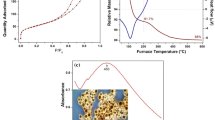Abstract
Stable dispersions of silver nanoparticles (Ag NPs) were synthesized employing glycerol as both a solvent and reducing agent, and 3-aminopropyl trimethoxysilane (APTMS) as a stabilizer. Average sizes varied between 13 and 55 nm, depending on the molar ratio of APTMS/Ag. Terminal alkoxysilanes reacted with OH groups of glycerol leading to the covalent bonding of glycerol moieties to the chain ends of the stabilizer. This produced extremely stable colloidal dispersions from which NPs could not be extracted with solvents immiscible with glycerol (as THF). Ag NPs were covalently bonded to the surface of a colloidal silica by hydrolysis/condensation of terminal Si–O–C bonds of the stabilizer with superficial SiOH bonds of silica. TEM images revealed the presence of individual NPs and small clusters of NPs attached to the silica surface. These clusters were presumably generated by intermolecular reactions among chain ends of the stabilizer producing Si–O–Si bonds. The antibacterial properties of the resulting powder were confirmed by conventional tests employing a culture of Escherichia Coli.










Similar content being viewed by others
References
Sondi I, Salopek-Sondi B (2004) Silver nanoparticles as antimicrobial agent: a case study on E. coli as a model for Gram-negative bacteria. J Colloid Interface Sci 275:177. doi:10.1016/j.jcis.2004.02.012
Rai M, Yadav A, Gade A (2009) Silver nanoparticles as a new generation of antimicrobials. Biotech Adv 27:76. doi:10.1016/j.biotechadv.2008.09.002
Rizzello L, Pompa PP (2014) Nanosilver-based antibacterial drugs and devices: mechanisms, methodological drawbacks, and guidelines. Chem Soc Rev 43:1501. doi:10.1039/c3cs60218d
Vukoje ID, Džunuzović ES, Vodnik VV, Dimitrijević S, Ahrenkiel SP, Nedeljković JM (2014) Synthesis, characterization, and antimicrobial activity of poly(GMA-co-EGDMA) polymer decorated with silver nanoparticles. J Mater Sci 49:6838–6844. doi:10.1007/s10853-014-8386-x
Zhang D, Toh GH, Lin H, Chen Y (2012) In situ synthesis of silver nanoparticles on silk fabric with PNP for antibacterial finishing. J Mater Sci 47:5721–5728. doi:10.1007/s10853-012-6462-7
Shinde VV, Jadhav PR, Kim JH, Patil PS (2013) One-step synthesis and characterization of anisotropic silver nanoparticles: application for enhanced antibacterial activity of natural fabric. J Mater Sci 48:8393–8401. doi:10.1007/s10583-013-7651-8
Ahamed M, Alsalhi MS, Siddiqui MK (2010) Silver nanoparticle applications and human health. Clinica Chim Acta 411:1841. doi:10.1016/j.cca.2010.08.016
Zhao CM, Wang WX (2010) Biokinetic uptake and efflux of silver nanoparticles in Daphnia magna. Environ Sci Technol 44:7699. doi:10.1021/es101484s
Frattini A, Pellegri N, Nicastro D, de Sanctis O (2005) Effect of amine groups in the synthesis of Ag nanoparticles using aminosilanes. Mater Chem Phys 94:148. doi:10.1016/j.matchemphys.2005.04.023
Nogueira AL, Machado RAF, de Souza AZ, Martinello F, Franco CV, Dutra GB (2014) Synthesis and characterization of silver nanoparticles produced with a bifunctional stabilizing agent. Ind Eng Chem Res 53:3426. doi:10.1021/ie4030903
Wu KH, Chang YC, Tsai WY, Huang MY, Yang CC (2010) Effect of amine groups on the synthesis and antibacterial performance of Ag nanoparticles dispersed in aminosilanes-modified silicate. Polym Degrad Stab 95:2328. doi:10.1016/j.polymdegradstab.2010.08.025
Wu KH, Liu CI, Yang CC, Wang GP, Chao CM (2011) Preparation and characterization of aminosilane-modified silicate supported with silver for antibacterial behavior. Mater Chem Phys 125:802. doi:10.1016/j.matchemphys.2010.09.055
Lv Y, Liu H, Wang Z, Liu S, Hao L, Sang Y, Liu D, Wang J, Boughton RI (2009) Silver nanoparticle-decorated porous ceramic composite for water treatment. J Membr Sci 331:50. doi:10.1016/j.memsci.2009.01.007
Fasce DP, Williams RJJ, Méchin F, Pascault JP, Llauro MF, Pétiaud R (1999) Synthesis and characterization of polyhedral silsesquioxanes bearing bulky functionalized substituents. Macromolecules 32:4757. doi:10.1021/ma981875p
Fasce DP, Williams RJJ, Erra-Balsells R, Ishikawa Y, Nonami H (2001) One-step synthesis of polyhedral silsesquioxanes bearing bulky substituents: UV-MALDI-TOF and ESI-TOF mass spectrometry characterization of reaction products. Macromolecules 34:3534. doi:10.1021/ma001711k
dell’Erba IE, Fasce DP, Williams RJJ, Erra-Balsells R, Fukuyama Y, Nonami H (2003) Poly(silsesquioxanes) derived from the hydrolytic condensation of organotrialkoxysilanes containing hydroxyl groups. J Organomet Chem 686:42. doi:10.1016/S0022-328X(03)00377-2
dell’Erba IE, Hoppe CE, Williams RJJ (2010) Synthesis of silver nanoparticles coated with OH-functionalized organic groups: dispersion and covalent bonding in epoxy networks. Langmuir 26:2042. doi:10.1021/la902568v
Patterson AL (1939) The Scherrer formula for X-ray particle size determination. Phys Rev 56:978. doi:10.1103/PhysRev.56.978
Langford JI, Wilson AJC (1978) Scherrer after sixty years: a survey and some new results in the determination of crystallite size. J Appl Cryst 11:102. doi:10.1107/S0021889878012844
dell’Erba IE, Hoppe CE, Williams RJJ (2012) Films of covalently bonded gold nanoparticles synthesized by a sol–gel process. J Nanopart Res 14:1098. doi:10.1007/s11051-012-1098-8
Acknowledgement
The financial support from the National Research Council (CONICET), the University of Mar del Plata and the National Agency for the Promotion of Science and Technology (ANPCyT), Argentina, is gratefully acknowledged. The authors wish to thank Giovani Pavoski and Prof. Griselda Barrera Galland for the ICP measurements at the UFRGS, Porto Alegre, Brazil.
Author information
Authors and Affiliations
Corresponding author
Ethics declarations
Conflict of interest
The authors declare no competing financial interest.
Rights and permissions
About this article
Cite this article
dell’Erba, I.E., Mansilla, A.Y., Hoppe, C.E. et al. Synthesis and characterization of an antibacterial powder based on the covalent bonding of aminosilane-stabilized silver nanoparticles to a colloidal silica. J Mater Sci 51, 3817–3823 (2016). https://doi.org/10.1007/s10853-015-9700-y
Received:
Accepted:
Published:
Issue Date:
DOI: https://doi.org/10.1007/s10853-015-9700-y




